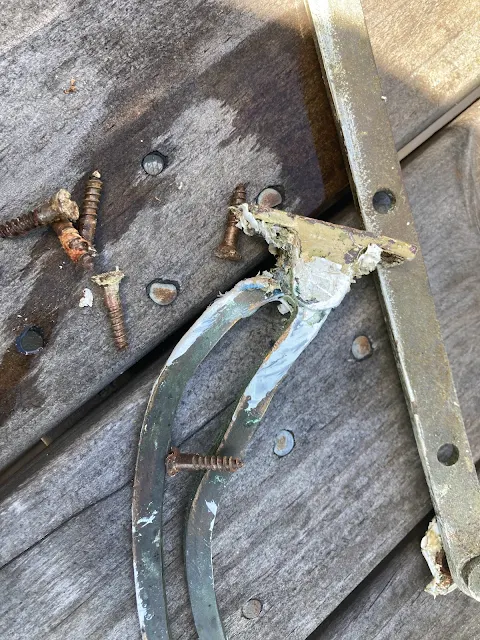Hydrochloric acid (HCl) cuts through baked-on finishes by protonating polymer chains and dissolving metal-oxide primers. The result is bare metal, ready for fresh paint or polish.
In this guide, you’ll learn the science behind the reaction, step-by-step prep, soak techniques, and how to neutralize and protect your parts when you’re done.
Guide to Using Hydrochloric Acid to Remove Paint and Grime from Metal
Using HCl isn’t magic—it’s chemistry. The strong acid breaks chemical bonds in paint polymers and oxidizes oxide layers, generating salts and hydrogen bubbles that lift coatings away. With proper technique, you can restore even heavily corroded or overpainted parts to factory finish.
Safety Measures
HCl is highly corrosive. Always don acid-resistant nitrile or neoprene gloves rated for chemical splash, a full-seal chemical splash goggles or face shield, and a respirator with acid gas cartridges. Wear a PVC or Tyvek apron and closed-toe boots. Assemble a spill kit: sodium bicarbonate, absorbent pads, and plastic scoops.Work outdoors or in a fume hood with at least 10 air changes per hour. If indoors, place a chemical-resistant tray under your container to catch drips. Keep a neutralizing station—bucket of 5% baking soda solution—within arm’s reach. Store HCl in an acid cabinet, away from organics and oxidizers. Label containers clearly and post hazard signage.
Effectiveness of HCl Acid as a paint stripper
HCl excels on alkyd and oil-based paints, which use polyester or epoxy linkages that acid hydrolyzes. You’ll see rapid softening within minutes. For water-based latex or urethane paints, expect slower action—up to 60 minutes—and possibly mild mechanical agitation (nylon brush) to finish removal.Test on a small inconspicuous area first. Variations in primer chemistry (zinc chromate, iron phosphate) or top-coat additives (siloxane, UV inhibitors) can affect soak time. Keep a log of concentration, temperature, and dwell time to refine your process for future projects.
The Chemical Reaction and Science of it all
When HCl meets iron oxide (rust) or metal primers, key reactions occur:
Fe2O3 + 6 HCl → 2 FeCl3 + 3 H2O
Fe + 2 HCl → FeCl2 + H2↑
Paint polymers (–CO–O– bonds) + HCl → fragmented oligomers + soluble salts.
Gas bubbles you see are H2 escaping. If bubbles vanish too quickly, the acid is spent—measure pH or add fresh HCl to maintain strength above pH 1.
Steps to Soak the Metal in Acid
- Prepare your bench: line with heavy-duty plastic and set up in a well-ventilated area.
- Use distilled or deionized water to dilute 10–15% HCl by volume (always add acid to water slowly).
- Transfer to a polyethylene, PP, or HDPE container—do not use metal or glass that can etch.
- Suspended parts on a nylon mesh rack so they don’t sit on the bottom and corrode unevenly.
- Soak for 20–30 minutes at 20–30 °C, stirring gently every 10 minutes.
Protect wood and concrete from splashes. Place trash cans or acid-resistant trays underneath.
Tap water contains minerals that form insoluble salts, which can stain metal or slow the reaction.
Plastic is inert to HCl; metal would corrode and contaminate your bath.
Ensure full submersion for uniform etching—flip parts halfway through the soak.
Monitor bubble rate and color change. Dark brown residue means primer is dissolving; white powder indicates paint binder breakdown.
- Drain acid safely into a suitable container for neutralization—never pour down the drain.
- Rinse parts under running water, then scrub with nylon or brass brush to remove softened paint fragments.
Neutralize gradually with baking soda, stirring until fizzing stops, test pH to reach 7 before disposal. You can use pH strips for this.
Avoid steel brushes—they scratch and can embed iron particles that promote rust.
Post-Soak Neutralization & Protection
After acid work, metal surfaces are etched and hydrophilic. Rinse twice: first with plain water, then with a 1% baking soda rinse to neutralize residual acid. Verify pH with strips—target pH 7–8.Dry parts immediately with compressed air or lint-free towels to prevent flash rust. Once dry, wipe on a thin coat of light machine oil or apply a zinc-phosphate primer before painting. Acid-etched surfaces offer superior primer adhesion.
Safety Advice & Storage
Store HCl in a cool, well-ventilated acid cabinet, in its original HDPE container with safety cap. Keep away from alkalis, chlorinated products, and sunlight. Maintain a spill kit with absorbent pads and neutralizer within 5 m of your workspace.
Never mix HCl with bleach or ammonia—deadly chlorine or chloramine gases can form. Always label secondary containers with concentration, date, and hazard information. Wear PPE until pH testing confirms no acid residue remains.
Conclusion
Hydrochloric avid is a powerful paint-stripper and rust dissolver—when handled with respect. By understanding the chemistry, preparing properly, and neutralizing responsibly, you’ll achieve pristine metal ready for refinishing. Keep detailed logs of concentration, temperature, and soak times to refine your process over multiple projects.For a greener alternative on delicate parts, explore our citric acid rust removal guide, which uses food-grade acid for mild corrosion without the hazards of HCl.


